Today’s post and photos were provided by guest author Miles Vining – thanks, Miles!
Lieutenant Colonel George Vincent Fosbery VC is primarily known for his most famous contribution to military small arms in the Webley-Fosbery automatic revolver which served Great Britain in the First World War. His most significant civilian contribution was the “Paradox”, which was a technique of rifling the last two inches of a shotgun barrel and thus allowing a common barrel to shoot both normal bird shot and solid slugs with relative accuracy out to 200 meters. It was so innovative that even the prestigious gun maker Holland & Holland took up incorporating it into some of their shotguns of the period. The Webley-Fosbery was phased out of service after World War One and Paradox production numbers declined in the 1930s, with none were being manufactured after World War Two. Fosbery was in dire financial straits when he died in 1907, despite his achievements – his grave is that of a pauper in England, marked by a wooden cross and a single plate that says “V Fosbery” and a bible inscription below it. But there is one design that was absolutely ahead of it’s time that Fosbery invented but never saw in mass production. It was the Fosbery Slide Action of 1891.

Fosbery began his venture into rifle designs in the late 1860s to compete for the service breechloader trials that eventually the Martini Henry would win. (Ed: details of Fosbery’s breechloading design) In the initial trials of 1867, he was up against the likes of Remington, Burton, Peabody, Martini, and Henry (separate submissions). This award carried with it a £600 award for winning, £1000 for submitting, and 1,000 rounds of ammunition along with £300 to cover the testing expense. Fosbery’s magazine and action designs were very complicated and involved a wrap-around magazine similar to a Johnson M1941. Later on, he designed another breechloader in 1885 as United States Patent No. 356311 and he intended the magazine to be used in other designs of the period to include the Lee bolt action and Spencer pump-action. His second magazine design, that of United States Patent No. 366,211 involved a box magazine that used scissor shaped springs to push the follower up. This development in designing rifle actions and magazines led way to his shotgun.
Patent No. 11,339 was filed by Fosbery in 1891 for a slide action magazine fed 16 bore shotgun. The purpose of the shotgun is not known, he could have it intentioned for riot control forces because of it’s rapid firepower or for the sporting market. Knowing that pump action and slide action firearms have never been very popular in Great Britain, it was probably intended for the former.


The surviving example evaluated seems to be constructed in Britain. Apart from it being a magazine fed shotgun (revolutionary in 1891) the outstanding feature of the weapon is it’s bolt head. It has a rotating 6 lug bolt head, operated by the pump handle on the stock. Common knowledge states that Eugene Stoner borrowed his bolt head design from Melvin Johnson, but where did Johnson get his design from? Fosbery’s rotating bolt head was patented almost 40 years before Johnson even began work on his rifles and light machine guns. Even down to the position of the extractor and ejector. There is evidence of a Scandinavian rotating bolt lug system design that predates Fosbery’s but the date and name of said design are not known at this time.
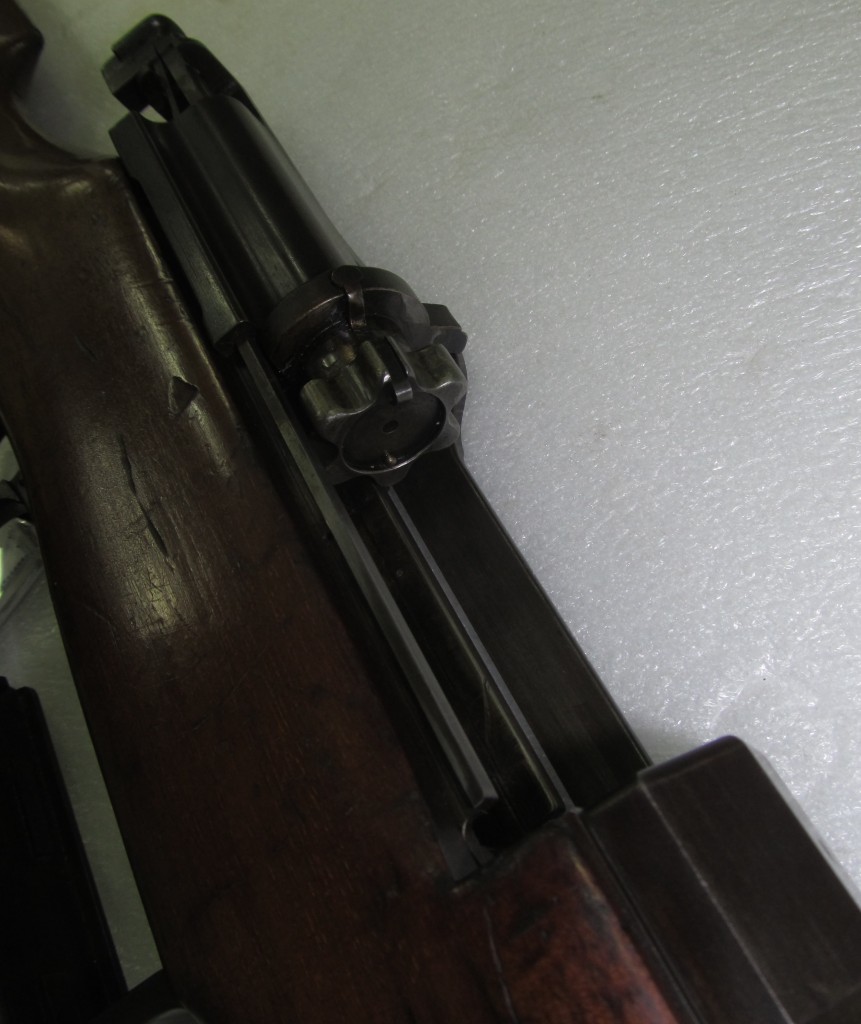
The bolt head leads to another innovation and that is of the pump action slam fire. It was common of slide actions of that time period to be manufactured without a battery safety, so if a shooter kept his finger depressing the trigger as the slide/pump was pushed forward, the instant the bolt would go in battery, the hammer would fall and the shell would go off. This could be handy in a rapid fire scenario but if only one shot was expected it could be a rude awakening. Fosbery used a description of this feature within the patent referring to a different breech closing device than the rotating bolt one, but it is still a similar design.
Another design feature that is possibly connected to modern designs is that of the slide/pump itself. If observed closely, the operating rod that the pump controls has a shape that is unmistakably similar to the operating rod on John Garand’s M1 rifle. Although there is no toggle lock system, the rod is secured to the pump and the bolt itself through 4 screws, 2 at either end of the rod.
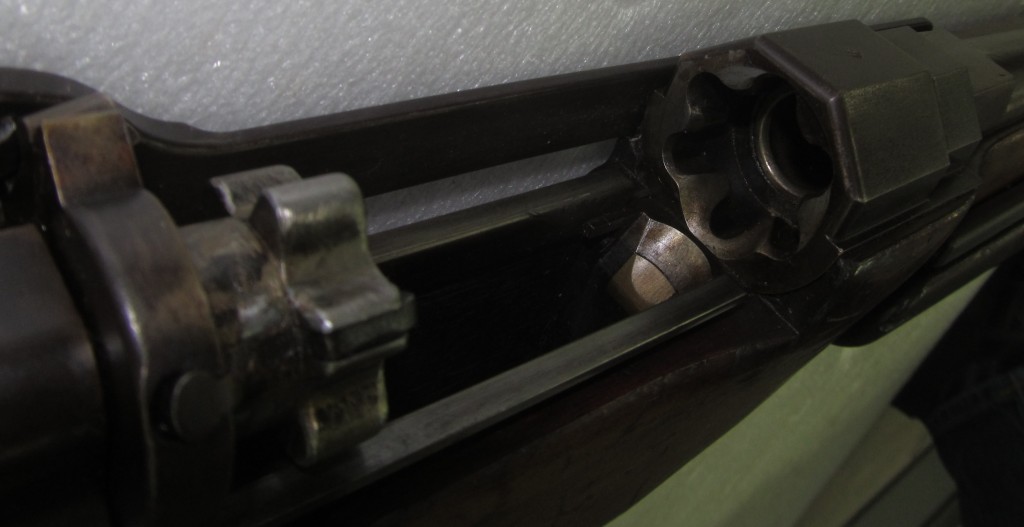
Two elements are missing from the example in the pictures, and that is the barrel and the assumed magazine. The barrel is a Winchester 16 bore barrel made in 1909, so thus the configuration of the original barrel is not known. The barrel must have been changed out by one of the owners after some years of ownership. All designs point to the use of a box magazine as the boxed shape of the trigger guard allows one, there’s magazine catch points, Fosbery had a number of magazine patents and the design doesn’t include room for a tubular magazine. But the biggest problem is where is the magazine! The example in the pictures does not come with one so if there ever was one, it is now lost to history.
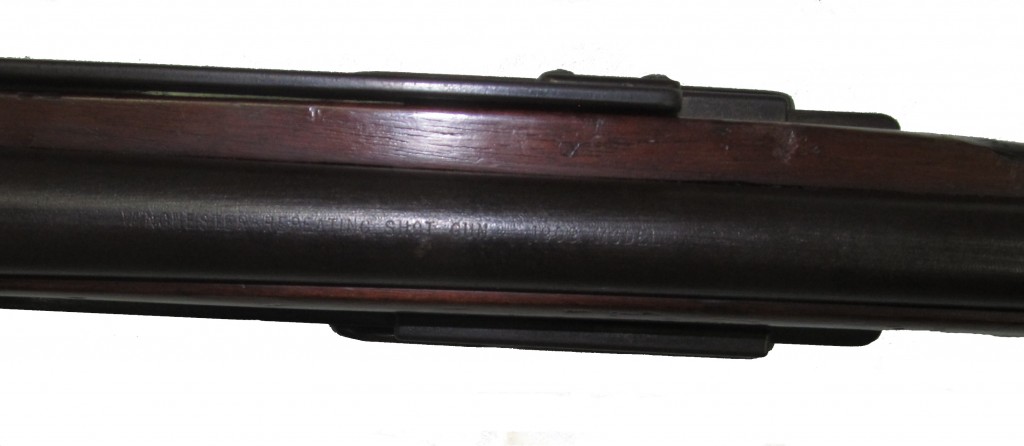
Today only two examples of the Slide Action of 1891 exist to the author’s knowledge. One is in a private collection in Florida, and the other is in the National Firearms Center in Leeds, England. The latter example is shown in photographs by the author. Much of this information is from pages 45-47 in the book Paradox – The Story of Colonel G.V. Fosbery, Holland & Holland and The Paradox Rifled Shot and Ball Gun by David J. Baker and Roger E. Lake, an excerpt from “American Artisan and Patent Record” Jul 17 1867. Also conversation with Doug Wicklund, Curator, NRA National Firearms Museum.

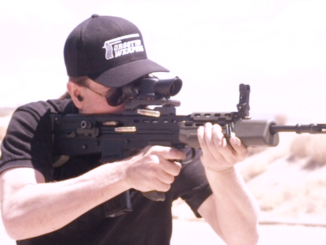

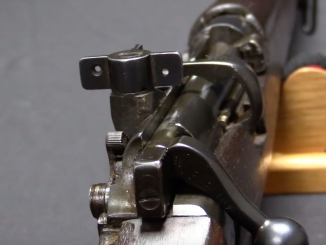
Interesting stuff — had no knowledge about Fosbery’s shotgun, thanks Mr Vining.
I probably won’t be the only one to point out, however, that the Webley-Fosbery revolver was never officially adopted by British forces, so it can’t really be said to have been “phased out”. The only ones that found their way into soldiers’ hands were privately purchased, as far as I’m aware.
Cheers!
Not exactly. A few hundred were purchased by the Royal Navy, so in a arrow sense it was officially adopted.
Really? You learn something new every day! Dowell was quite adamant that none were officially adopted, but I guess if anyone would know it’d be you, Mr Ferguson.
Cheers!
Sorry, that should have said ‘narrow’.
But yes – here’s a reference for the RN Webley-Fosberys; even fewer than I remembered actually;
The Royal Navy accepted into service small numbers of other different pistols. These included a total of
66 Webley Fosbery .455 semi automatic revolvers, purchased from the trade in June and December
1915, for the RNAS.(Appendix: Image 15)
p.23 http://www.worldwar1.com/tripwire/pdf/davidthomas.pdf
Been AFK for a few days and have only just seen this — just wanted to say that this is one fascinating document; thanks for sharing!
On first photo it looks like this shotgun has not front sight. It really has not or it is invisible on this photo?
“Patent No. 11,339”
It refers to US other country? US Patent 11339 is for “Apparatus foe”: http://www.google.com/patents/US11339
I am assuming it’s a UK patent, not a US one, but I will admit that I didn’t look it up.
If it’s a British patent, you need the year as well as the number, British patent numbers at that time began again at zero each year.
At that time, patent numbers were assigned as soon as you made your application. I’ve conducted some fairly exhaustive searches and there just isn’t a UK patent of that number. Chances are that his patent wasn’t actually granted, which seems odd looking back at this revolutionary bolt design. Perhaps Fosbery didn’t actually seek to patent the bolt though? 11339 may have covered the pump action only, I don’t know.
“Apart from it being a magazine fed shotgun (revolutionary in 1891)”
If by “magazine” you mean “detachable magazine” it is true. The older Winchester Model 1887 is also magazine-feed shotgun but with fixed magazine. The detachable magazine is feature which increase rate-of-fire.
Yes, detachable magazine.
How do you suppose the magazine would be inserted, simply dropped through the gap between the breech and the bolt when it’s open? Doesn’t look like it could go in from the bottom.
Back in the 1960s, Universal made a pump-action carbine, the Vulcan, chambered for .44 Remington Magnum;
http://www.m1carbinesinc.com/MoVulright30.jpg
While obviously adapted from Universal’s .30 M1 Carbine, the pump system strongly resembles Fosbery’s.
The Vulcan was manufactured from 1963 to 1967, and only about 2500 were ever made. They must have been slow sellers, as my 1970 Stoeger “Shooter’s Bible” still lists it as available from Universal. I was never really interested, I was too busy lusting after the synthetic Monte Carlo stocked Model 1200 in dark green Teflon right above it on the page.
cheers
eon
“pump-action carbine”
The slide-action carbines (aswell rifles) never get influential popularity in United States, until the introduction of Remington Model 760. This fact is quite weird considering that the slide-action was very popular action of repeating shotgun.
BTW: Modern IMI Timberwolf carbine bears for me striking exterior resemblance to Remington Model 25 carbine, however I don’t know the internals of IMI Timberwolf, so I hope that someone having more knowledge about both of this firearms will say that IMI Timberwolf is direct copy of Model 25 only chambered for other cartridge or it is totally different design only having very similar appearance.
I always love seeing how older design innovations trickle down into newer ones.
That bolt is very interesting.
The plunger ejector, the use of the receiver rails with a cut out at the front to index the bolt head from rotating as it reciprocates, rather than having seperate lug races, these are features which I had assumed came much later.
There do seem to be some complex machining jobs on the gun, for example the elaborate trigger and mag guard,
However the bolt lugs and the locking seats (I’m less certain of the locking seats), look like they were designed to be produced on automatic gear shapers which were available at that time (eg Bilgram and Fellows shapers) Infact the bolt lugs look like candidates for forming by hobbing.
This really is an interesting gun, thanks for sharing.
What an amazing design indeed!
Is it known if the other example in Florida is in a more complete condition?
In regards to the patent information, that patent number was taken from the book that I referenced in the text as it was printed. I also assume it is a British patent but there is no other information given about it other than it was Fosbery’s.
And thanks! I should have wrote “detachable magazine” instead of just “magazine”! And in regards to the barrel’s front sight, notice how it doesn’t have a rear sight either. The original sights were probably on the original barrel but the current barrel on the Fosbery comes from a completely different firearm, that of a Winchester shotgun from at least 1909.
Even considering fact that it is barrel from other weapon, lack of sights is interesting. Apparently, someone that make barrel change don’t care about sights and therefore aiming.
Awesome post !!!
Look at the feed ramps in locking recesses (or barrel extension) … reminds ones in AR15
So if the magazine fits inside that oversized trigger guard, then it’s capacity must be 2 or 3 rounds (+1).
Seems mag insertion was quite tricky … or maybe the box magazine was inserted from top of the receiver (like M1 Garand’s en-bloc clip) ??? Any ideas?
Now I suspect that inserting the magazines could need removing the trigger guard. It trigger guard attached to rifle in way permitting its easy removing? Maybe it is not detachable in modern sense, i.e. it is detachable but not to speed-up reloading? Note that then-standard British rifle: the MLM has detachable box, but soldiers were trained to load these rifles from chargers and to treat swapping magazines as a solution to damaged magazine problem.
Looking at the closeup, I think the triggerguard is in two sections; note the “shelf” just ahead of the trigger. There also seems to be a catch there, either sliding or possibly a press-type.
I suspect the forward section of the guard hinges down on a pin at the front, to allow the magazine to be removed or inserted. Once the magazine is in place, the guard hinges back up and locks, acting as both a catch and as a support to ensure that the magazine doesn’t fall out.
If not for the obvious pump up front, this setup could easily be mistaken for a (rather clumsy) lever-action.
cheers
eon
the grave of Mr. Fosbury has been replaced with a very smart stone cross and surround with a list of his life and work, worth a visit if one is in Bath